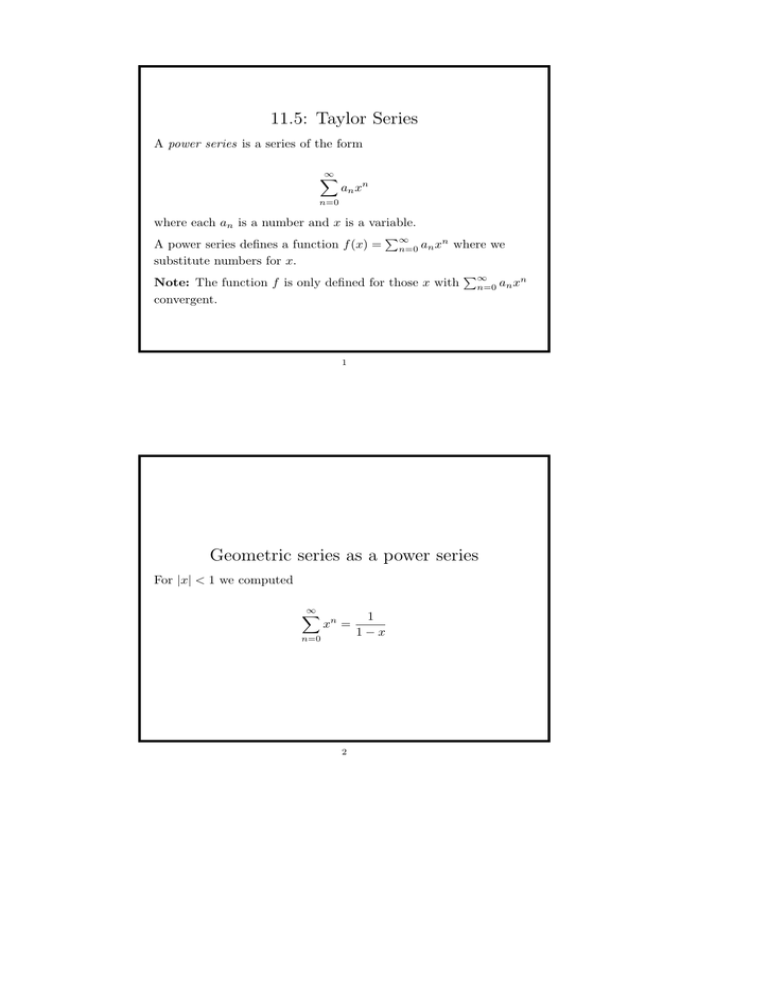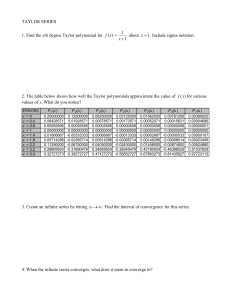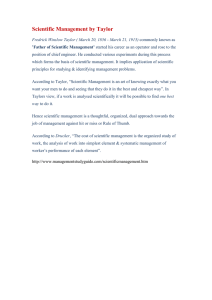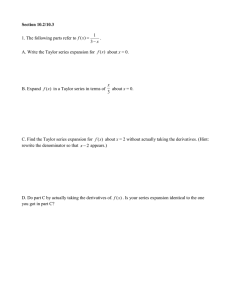11.5: Taylor Series Geometric series as a power series
advertisement

11.5: Taylor Series A power series is a series of the form ∞ X an xn n=0 where each an is a number and x is a variable. P∞ A power series defines a function f (x) = n=0 an xn where we substitute numbers for x. P∞ Note: The function f is only defined for those x with n=0 an xn convergent. 1 Geometric series as a power series For |x| < 1 we computed ∞ X xn = n=0 2 1 1−x Taylor Series If f (x) is an infinitely differentiable function, then the Taylor series of f (x) at a is the series ∞ X f (n) (a) (x − a)n n! n=0 3 Example Compute the Taylor series of f (x) = ex at a = 0. 4 Solution We know f (n) (x) = ex for all n ≥ 0. So f (n) (0) = 1 and the Taylor series of f (x) = ex at a = 0 is ∞ X 1 n x n! n=0 5 Example Compute the Taylor series at a = 1 of f (x) = 6 √ x. Solution 1 Write f (x) = x 2 . Then f 0 (x) = 12 x , f 00 (x) = −1 −3 2 , 4 x (−1)4+1 5·3·1 −7 −5 −7 2 = x 2 . In general, 16 x 24 n+1 −2n−1 (−1) (2n−1)·(2n−3)···3·1 x 2 so that 2n n+1 (−1) (2n−1)·(2n−3)···3·1 and the Taylor series of 2n f 000 (x) = 38 x f (n) (x) = −1 2 −5 2 , f (4) (x) = f (n) (1) = √ f (x) = x at a = 1 is 1+ ∞ X n=1 (−1)n+1 (2n − 1)(2n − 3) · · · 3 · 1 (x − 1)n n n!2 7 Convergence of Taylor series Given an infinitely differentiable function f (x) with Taylor series P∞ P∞ (at a) n=0 bn (x − a)n either n=0 bn (x − a)n converges and is equal to f (x) for every number x or there is a number R (called the P∞ radius of convergence) for which n=0 bn (x − a)n converges and is P∞ equal to f (x) for |x − a| < R while n=0 bn (x − a)n diverges for |x − a| > R. 8 Examples • ∞ X 1 n e = x n! n=0 x for all x. • ∞ X 1 = xn 1 − x n=0 for |x| < 1 and diverges for |x| > 1 9 Operations on Taylor series (n) P∞ P∞ Differentiation: If f (x) = n=0 f n!(0) xn = n=0 an xn , then (n+1) P∞ P∞ f 0 (x) = n=0 f n! (0) xn = n=0 nan xn−1 . P∞ Integration: If f (x) = n=0 an xn , then R P∞ an n+1 f (x)dx = C + n=0 n+1 x . P∞ P∞ Products: If f (x) = n=0 an xn and g(x) = n=0 bn xn , then P∞ Pn f (x) · g(x) = n=0 ( i=0 ai bn−i )xn . P∞ Composition (monomial case): If f (x) = n=0 an xn and m is P∞ a positive integer, then f (xm ) = n=0 an xnm . 10 Example Compute the Taylor series at a = 0 of R 2 ex dx. 11 Solution P∞ 1 n P∞ 1 2n 2 We know ex = n=0 n! x . So, ex = n=0 n! x . Integrating, R x2 R P∞ 1 2n P∞ 1 2n+1 e dx = . n=0 n! x dx = C + n=0 n!(2n+1) x R x2 1 5 1 7 That is, e dx = C + x + 16 x3 + 30 x + 98 x + ···. 12 Example Find the Taylor series at zero of 1+x2 1−x3 . 13 Solution P∞ 3n 1 un so that 1−x 3 = n=0 x . P∞ 3n P∞ 1+x2 2 Multiplying, 1−x = n=0 (x3n + x3n+2 ) = 3 = (1 + x ) n=0 x 1 + x2 + x3 + x5 + x6 + x8 + x9 + x11 + · · · We know 1 1−u = P∞ n=0 14


